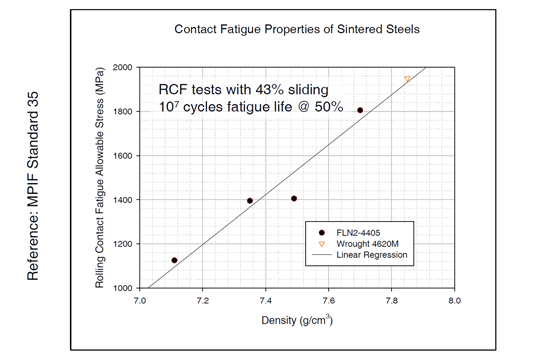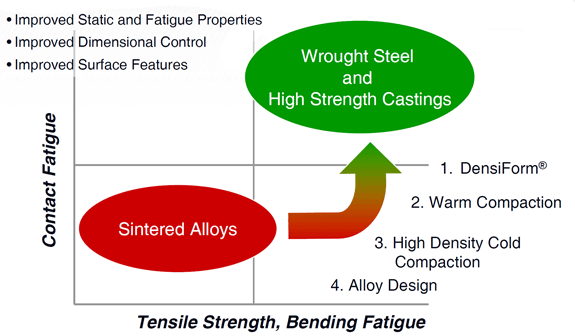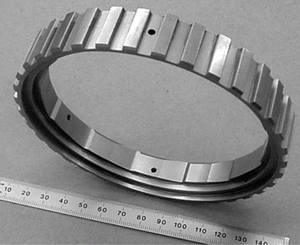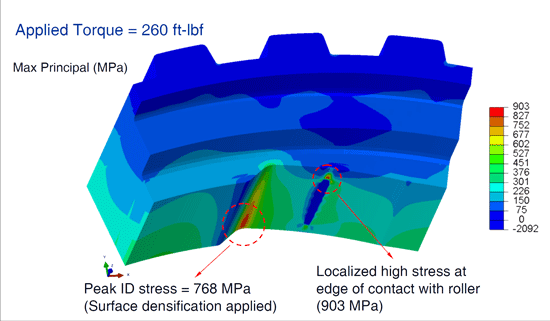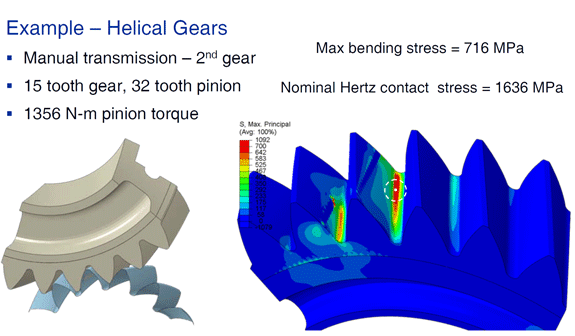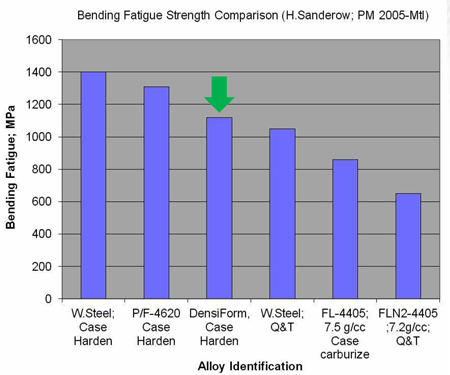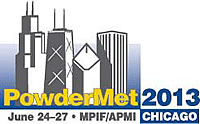PowderMet 2013: High-density technology for future PM growth
Conventional press and sinter
The presentation began with a review of the capabilities of conventional press/sinter PM processing in relation to applications, density levels and mechanical properties. Mechanical properties were shown to clearly depend on density; trend lines for contact fatigue and bending fatigue for conventional PM materials could be used to predict mechanical properties for fully dense wrought steel. This review culminated in the conclusion that the maximum achievable contact fatigue strength (a property key to the target higher performance applications) is around 1400 MPa at typical press densities of 7.3 g/cm3 (Fig. 1).
Comparison of this value with the contact fatigue requirements of a range of applications (one-way clutch races, light and heavy duty cam lobes) lead to the conclusion that conventionally processed PM materials cannot satisfy the requirements for torque convertor outer race cams (Fig. 2).
An emphasis on surface densification
A need for densification was therefore defined and, based on the recognition that the stress fields in the targeted applications are highly localised in the surface layers of the component, the emphasis was on surface densification methods, in particular the company’s proprietary DensiForm® technology. Fig. 3 shows schematically the effect of DensiForm® technology on bending fatigue and contact fatigue strength, as compared with bulk densification PM technologies and in the context of wrought steel performance levels.
Growth opportunities
Growth opportunities were highlighted in components such as:
- Torque convertor races for automatic transmissions
- Lower speed gears for manual transmissions.
Torque converter races in particular call for:
- Contact stress >2500 MPa
- Maximum tensile stress >700 MPa
- Von Mises >1800 MPa.
In the example cited of an outer race for a torque convertor roller one-way clutch (Fig. 4), rollers lock-up against cam and race under torque with high stress (hoop and contact) at full torque (Fig. 5).
Surface densification can be effective with this type of application as maximum principal stress and normal contact stress fall by 54% and 77% respectively over the first 1 mm from the surface. In relation to the “core” strength requirements, it was concluded that higher core density is a key to success with highly loaded applications.
Turning to manual transmission gear applications, the example was considered of a 2nd speed helical gear (Fig. 6). The nature of the stress field for this type of component requires high strength near the surface and moderate strength in the core. It was concluded that the key to success here is surface densification with moderate core density.
The influence of DensiForm® on bending fatigue strength is summarised in Fig. 7 in comparison with PM materials with a range of bulk densities, including fully dense Powder Forged material, and with wrought steel. In the case-hardened condition, DensiForm® delivers a bending fatigue strength somewhat lower than Powder Forging or a wrought steel route, but, at >1000 MPa, the level achieved is substantially higher than the maximum bending stress experienced by the 2nd speed gear.
For higher speed manual transmission gears, it was again concluded that surface densification with a higher core density may be the key to attacking this market.
References
[1] R Parameswaran, S Nigaruga, M Bird, High-Density Technology for Future Powder Metal Growth Opportunities, as presented at PowderMet2013, MPIF, USA
Author
Dr David Whittaker is a consultant to the Powder Metallurgy and associated industries. Contact +44 1902 338498 email: [email protected]
PowderMet2013 was organised by the Metal Powder Industries Federation. For more information please visit the MPIF website: www.mpif.org
News | Articles | Market reviews | Search directory | Subscribe to e-newsletter



